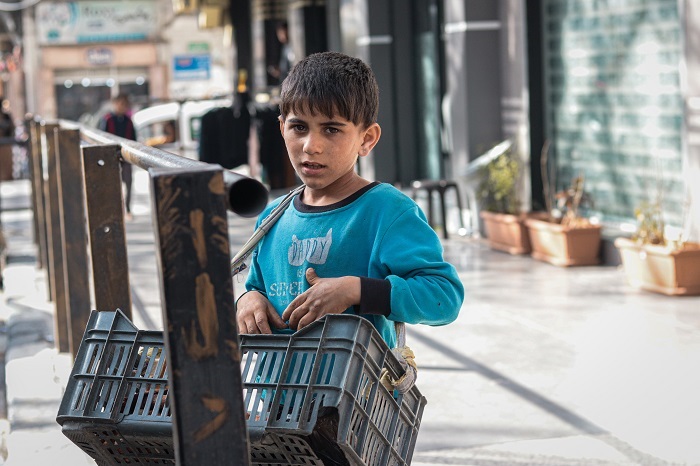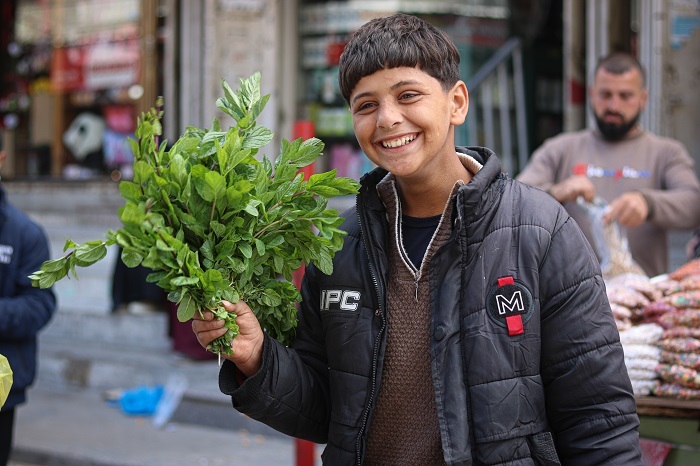By Aseel Kabariti | –
Gaza ( We Are Not Numbers) – Child labor takes many forms. Many people picture a child in a factory, but sometimes it’s an adorable kid pulling on your sleeve in a market.
“Could you please buy some mint from me?” asked a young boy with a warm smile and impressively cool haircut.
It was a sunny day, and Al-Shejaiya market was full of sounds: people crowding stalls, voices of street vendors and buyers haggling. My little sister and I could barely hear our own voices above the commotion. We were buying supplies for Ramadan when the young boy popped up.
“I am going to take a picture of you instead,” I replied, freezing his grin with my camera.
My little sister suggested posting it on Instagram, but I hesitated. Does posting a cute picture normalize this kind of child labor or draw much-needed attention?
Child labor in Gaza
According to a 2018 UNICEF report, almost one-third of Palestinian families live below the poverty line—with unemployment at 53.7 percent in the Gaza Strip. The situation has only become worse since the pandemic. As a result, the number of children working in family shops or as street vendors has increased dramatically. On every corner in Gaza City’s popular streets, you can find at least one child begging passersby to purchase whatever they are selling. Many of these kids have no choice; they may be providing the only source of income for their family.
Photo by Aseel Kabariti.
Is child labor always bad?
The International Labor Organization defines child labor as any kind of work “that deprives children of their childhood, their potential and their dignity, and that is harmful to physical and mental development.” The 1973 Minimum Age Conventions “sets the general minimum age for admission to employment or work at 15 years (13 for light work).”
But to play devil’s advocate, these definitions, while well-intentioned morally, fail to consider the specific conditions and personal experience of a working child. There are three important points to consider.
First, international organizations have drawn the age line for work without considering country-specific circumstances. There are many families in Gaza that totally depend on their children to help provide essential support to make ends meet, including basic food and water. If international law were followed here and these kids were prevented from working, some families would literally starve. When faced with the choice between the children working or members of the family dying from hunger, what would you choose?
Second, there are numerous double standards when it comes to deciding if a child’s work is good or bad for them. For example, society has accepted that children can work as models, musicians, and actors, but not in shops or stores. The main argument is that the latter kind of work deprives children of their childhood and doesn’t help them improve their skills.
But working in shops or selling things to customers can indeed help children learn and grow, improving their communication, leadership and marketing skills. And work can teach children many practical things they won’t learn in middle school and that might help them secure better jobs in the future.
Third, working and going to school aren’t mutually exclusive. In fact, most working children go to school. And work can help children along their educational journeys, especially in this period, which demands an internet connection to complete the educational process—especially after the outbreak of COVID-19, which pushed most education online.
What should we do?
The child my sister and I met in the market has been forced to spend his childhood working. Social, political and economic conditions beyond his control have shaped his life. While he shouldn’t have to work so his family can survive, the solution isn’t to criminalize child labor in Gaza. It’s to support economic development and create jobs, followed by educational and social support for these children. And for children who have to work, there are some educational benefits and it shouldn’t necessarily be viewed as being any different from a child actor or musician.
Mentor: Ben Gass
Featured photo by Aseel Kabariti




 © 2025 All Rights Reserved
© 2025 All Rights Reserved